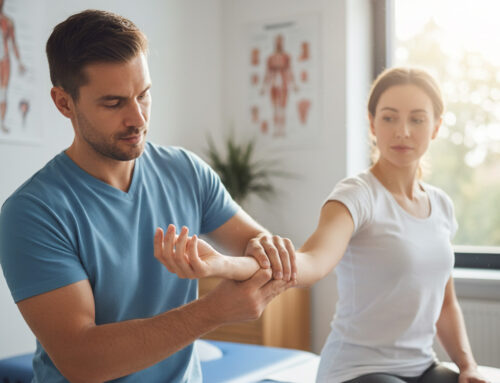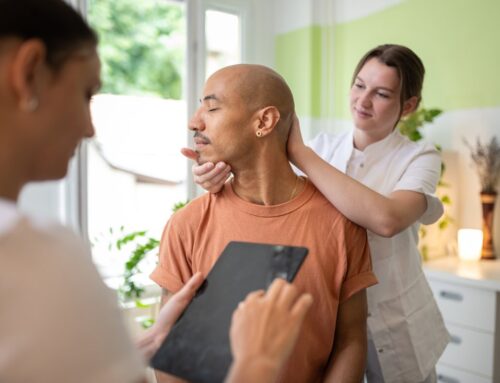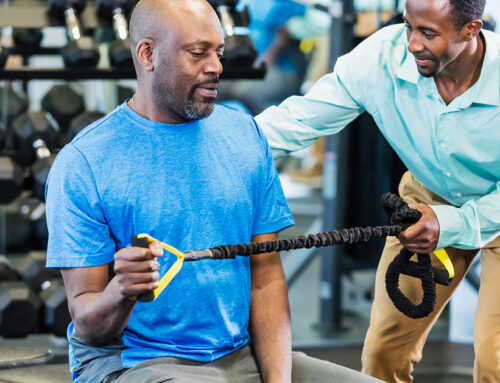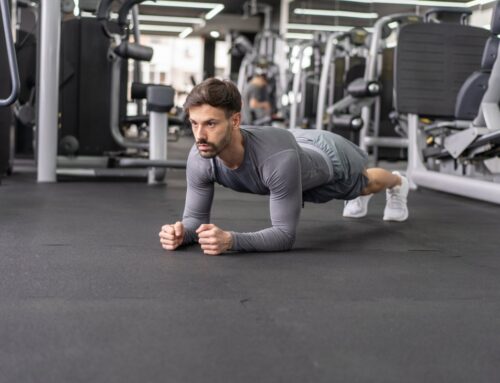Understanding and Managing Hip Pain: Causes, Conditions, and Keeping Your Hips Healthy
Our hips are involved in many of our fundamental movements, such as walking, squatting and getting up from sitting. We rely on our hips to be capable and pain-free, and many of us might not realize how much we use them until they become painful.
 Our hips are a “ball and socket” joint. They move in many different directions (different from a hinge joint), and therefore, there are many different muscles that act on the area. In general, hip pain most often manifests in the front, at the crease near our hip flexors. This is, of course, a generalization, but perhaps helpful if you’re in pain and trying to describe it as hip pain or lower back pain. It is very common for pelvis and lower back pain to refer down into the gluteal area. Again, while hip joint dysfunction can send pain to the gluteals, it most often manifests in the front and commonly, back pain refers to the gluteals.
Our hips are a “ball and socket” joint. They move in many different directions (different from a hinge joint), and therefore, there are many different muscles that act on the area. In general, hip pain most often manifests in the front, at the crease near our hip flexors. This is, of course, a generalization, but perhaps helpful if you’re in pain and trying to describe it as hip pain or lower back pain. It is very common for pelvis and lower back pain to refer down into the gluteal area. Again, while hip joint dysfunction can send pain to the gluteals, it most often manifests in the front and commonly, back pain refers to the gluteals.
Our hips have a very important relationship with our lower back. For many movements, our hips and spine work together to accomplish a task. For example, picking something off the ground requires a deep flexion of the hip and likely some flexion of the spine, depending on the technique. As a chiropractor, I often use this relationship as a strategy for patients with acute lower back pain. While in pain, moving with a hip-dominant pattern to offload stress from the lower back can be helpful. An example of this movement strategy is a goblet squat. A wider stance and centring the weight can be helpful when the lower back is painful. Obviously, this can be a challenge when someone has injured or painful hips.
Common Conditions Affecting the Hip
Labral Tears
A hip labral tear is an injury to the labrum, the ring of cartilage that follows the outside rim of the socket of the hip joint. The labrum acts like a gasket to help hold the ball of the joint (the femoral head) securely in place and allows smooth movement. Labral tears can result from trauma, repetitive motion (especially in athletes), structural abnormalities like femoroacetabular impingement (FAI), or degeneration over time. Symptoms include hip or groin pain, a clicking or locking sensation, stiffness, and limited range of motion. Diagnosis is usually a combination of physical examination, MRI arthrogram, or sometimes hip arthroscopy. Most cases do well with non-surgical treatment like relative rest, physiotherapy and pain control. Some labral tears require surgery. Arthroscopic surgery is performed to repair or remove the torn part of the labrum if conservative treatments don’t help.
Snapping Hip
Snapping hip syndrome (also known as coxa saltans) is a condition where a snapping or popping sound is heard or felt in the hip during movement. It’s usually painless but can become irritating or painful with activity. The most common type is external snapping hip, where the iliotibial (IT) band or gluteus maximus tendon snapping over the greater trochanter (outer hip bone). Internal snapping hip is caused by the iliopsoas tendon snapping over structures in the front of the hip, such as the femoral head or iliopectineal eminence. In general, snapping hip usually occurs during hip flexion/extension, especially with repetitive motion (like running, dancing, or rising from a chair). Imaging is usually not necessary for snapping hip and treatment is usually conservative. Stretching, strengthening exercises (especially hip stabilizers), rest and medication can be reasonable thoughts for conservative management. Surgery is rarely needed, and this condition is normally not anything serious.
Hip Bursitis
Bursas are small fluid-filled sacs that cushion and reduce friction between tissues like bone, muscles, and tendons around the hip joint. When they get irritated, they can swell and inflame, thus leading to the term “bursitis.” There are two main types. Trochanteric bursitis is the most common form of hip bursitis, and it affects the bursa over the greater trochanter on the outer hip.
Iliopsoas bursitis affects the bursa near the front of the hip, under the iliopsoas muscle.
Symptoms of bursitis include pain on the outer part of the hip or thigh. It can be sharp but also aching for some people. It is worsened with pressure (e.g., lying on the affected side), walking, stairs, or prolonged standing. With iliopsoas bursitis, pain is more in the groin/front hip. It is uncertain as to why some people get bursitis in the hip, but overuse or repetitive stress, injury or hitting the area are all possibilities. The diagnosis of bursitis is generally made through a clinical examination, but imaging (like ultrasound or MRI) can assist in confirming the presence of an inflamed bursa. Treatment typically consists of laser therapy, ice, exercises like stretching and strengthening and then education on what to do if it’s being stubborn. For some, corticosteroid injections are indicated if there is no improvement with an appropriate effort at conservative care. Surgery is rarely needed, only for chronic, severe cases.
Muscle Strains in the Hip
Muscle strains around the hip joint are injuries to the muscle fibers or tendons (which connect muscles to bones) caused by sudden or forceful movement. Commonly affected muscles include the hip flexors, adductors (e.g., adductor longus—often involved in “groin pulls”), hamstrings and gluteal muscles (gluteus medius/minimus/ maximus). Symptoms of muscle strains include sudden pain during activity or stretching, swelling, bruising, or tenderness. The area may become weak and stiff, and pain will likely occur with using or stretching the affected muscle. Most muscle strains occur from a sudden acceleration/deceleration movement. This condition can be diagnosed clinically, and further imaging is normally not necessary. The treatment of a muscle strain includes physical therapy and the possible use of modalities like laser.
Hip Arthritis
A discussion of conditions affecting the hip certainly wouldn’t be complete without discussing hip arthritis. Also known as degeneration of the hip or osteoarthritis, this is a condition that will impact all of us at some point in our lives if we live long enough. Our joints will wear down with time. For some people, there is a genetic link that predisposes them to the hip wearing down a little quicker than for other people. Another reason the hip might wear down earlier than others is because of a prior injury. For example, a few hip sprains and a labral tear in the hip when someone is younger will likely accelerate the breakdown of the joint over the long term. X-rays are a helpful tool in getting a gauge on the extent of the degeneration of the joint. An MRI or CT scan isn’t usually required if the suspicion is hip arthritis. Clinically, a moderately to severely worn hip is reasonably easy to detect by an experienced practitioner. Arthritic hips don’t typically move well when passively brought through a normal range of motion. This clue, along with hearing a person’s story of their hip can help a practitioner decipher whether hip arthritis is the cause of their pain. As mentioned in previous blog posts, a little wear and tear on a joint surface is normal and usually nothing to worry about. The strategy is the same: keep the joint mobile and the muscles around the joint strong. If possible, try and identify the activities that cause irritation and see if they can be modified or improved so that they no longer perpetuate the symptoms. Should all this fail, unfortunately, some people have no choice but to get a hip replacement. Thankfully, surgeons have improved the technique immensely over the years, and most patients tell us they are glad they finally made the decision so they could resume a more normal, pain-free lifestyle. Obviously, hip replacement is a careful consideration that is discussed with an orthopedic surgeon and is often an obvious decision when pain has impacted your lifestyle significantly.
Keeping Your Hips Healthy
You can’t go wrong with strong. Getting the hip muscles stronger is almost always a good idea. Squatting, lunges and step-ups are great exercises for the gluteus maximus. Gluteus medius and minimus benefit from lateral motions like monster walks and banded clamshells. In my opinion, the choice of which exercises to do isn’t as important as other factors related to strengthening. These factors include pain, confidence performing the movement, depth of movement, speed of the movement, how often to do them and how much weight is being used. Consulting with a suitable practitioner who can assist you in designing a program that you’ll do on a regular basis over the longer term is the best option.

Mobility in the hip is also important. Although you don’t need to be a master yogi, most of us at least require enough movement to put on shoes and socks as well as sit comfortably. I have met patients in their seventies and eighties who can squat all the way to the ground, so they are sitting on their heels. Unfortunately, I’ve also met people in their forties who can’t get to ninety degrees. As with strengthening, consulting with a chiropractor or physiotherapist is a good way to get the appropriate mobility exercises for you.
Over the last few blogs, we’ve built a list of reasonable recommendations for adults who want to stay as healthy and athletic as possible and to hopefully avoid common injuries. Adding to that list would be maintaining a reasonable level of hip mobility, practising functional hip movements like squatting and getting up off the ground. Strengthening the muscles around the hip through movements like squats, lunges and banded clam exercises (as examples) and learning how to use your hips as much as possible for periods of lower back dysfunction are reasonable things to consider as we age. As mentioned in previous blogs, we need to dispel the myth that exercise will wear down your joints, but rather, exercise will help build up the ability of your joints and help you live as capable and athletic as possible. Working within your limits is important, and is when the assistance of a professional like a physiotherapist or chiropractor can be helpful.








